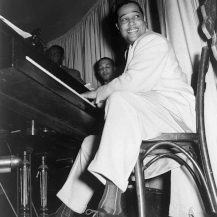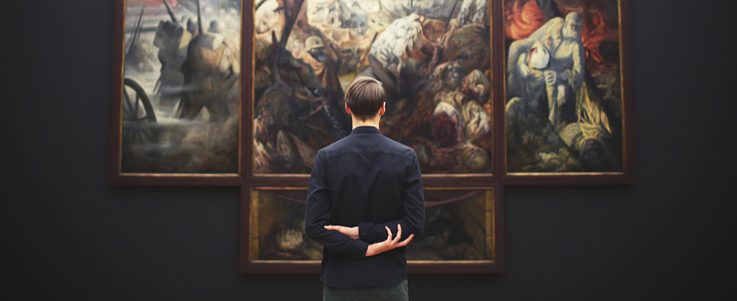Throughout its twentieth-century evolution from mass entertainment to elite art, African-American jazz has reflected social tensions surrounding race, class, “cultivated” taste, and “vernacular” pop culture. Critics have frequently compared jazz to European classical music, whether as a point of contrast, competition, or an avenue of cultural appropriation.
At the same time, social elites and progressive activists like John Hammond (producer for Billie Holiday and Count Basie) and Norman Granz (producer for Charlie Parker and Ella Fitzgerald) championed jazz in a century-long struggle for serious recognition, often in parallel with campaigns for civil rights and international dialogue, a project that continues in UNESCO’s International Jazz Day initiated in 2011. But the eventual cliché of jazz’s social ascent and complementary esotericism made it, ironically or inevitably, an easy trope for bourgeois posturing. Once relegated to brothels and taxi dance halls, the beginning of the twenty-first century found jazz increasingly synonymous with wine-tasting tours and holiday mall-shopping.
1924: Popular bandleader Paul Whiteman’s New York concert, An Experiment in Modern Music, is best remembered for the premiere of George Gershwin’s jazz-classical hybrid Rhapsody in Blue, blending European classical form with blues harmony and expression. But the program also included an excruciatingly modernist attempt to place the young music in cultural context, including a sequence that compared jazz from “ten years ago” with “the tremendous strides which have been made in popular music”, and even forecasting “the evolution of an American school which will equal those of foreign origin.” While the trajectory of jazz laid out in Whiteman’s program was essentially white and symphonic, it also helped to establish the music’s role in elite commentary and consumption.
 Duke Ellington at the Hurricane Club
| © Gordon Parks, Wikipedia, edited, CC0-1.0
1943: A fundraiser for Russian war relief featuring Duke Ellington’s orchestra was not the first jazz concert at prestigious Carnegie Hall, but the premiere of the 40-minute-long composition Black, Brown & Beige was immediately recognized as a milestone. The heavily programmatic presentation—a symphonic-form “tone parallel” to the African-American experience—may have put parallels to European classical traditions in starker relief than Ellington intended, but the event established the potential for jazz as a symbolic civil rights vehicle in addition to being “serious” concert music. Ellington himself evolved into an icon of jazz-as-art: accepting honorary doctorates, performing for international royalty, and receiving a tribute at the White House.
Duke Ellington at the Hurricane Club
| © Gordon Parks, Wikipedia, edited, CC0-1.0
1943: A fundraiser for Russian war relief featuring Duke Ellington’s orchestra was not the first jazz concert at prestigious Carnegie Hall, but the premiere of the 40-minute-long composition Black, Brown & Beige was immediately recognized as a milestone. The heavily programmatic presentation—a symphonic-form “tone parallel” to the African-American experience—may have put parallels to European classical traditions in starker relief than Ellington intended, but the event established the potential for jazz as a symbolic civil rights vehicle in addition to being “serious” concert music. Ellington himself evolved into an icon of jazz-as-art: accepting honorary doctorates, performing for international royalty, and receiving a tribute at the White House.
1957: By the 1950s, jazz had made inroads into music conservatories, but was not yet established in broader academia. The 1957–60 “Lenox School of Jazz” summer concert series, staged at the Music Inn venue in Massachusetts, included groundbreaking symposia for “musicians and enthusiasts,” exploring jazz’s “international development and its relationship to other arts.” Lectures by historian Marshall Stearns provided retrospective context, but the aesthetic models for jazz in academia were drawn from the music’s post-WWII modernist forms: performer-participants included leading proponents of modal jazz (composer-theorist George Russell), Third Stream (jazz-classical scholar Gunther Schuller), and the blossoming “free jazz” movement (saxophonist Ornette Coleman). The more challenging sounds of modern jazz, often dissonant as well as instrumental, would increasingly turn toward academia as their primary milieu.
1987: When Congress declared jazz a “national American treasure” in 1987, New York’s Lincoln Center for the Performing Arts represented the apex of cultural acknowledgement. A subsequent call to include jazz in its programming, funded in part by the NEA, eventually evolved into a de facto national jazz orchestra. Yet the outspoken stylistic conservatism and controversial hiring practices of artistic director Wynton Marsalis arguably precluded the music from achieving broader popular appeal; since fundraising requirements beget subscription ticketing, corporate sponsorship, and advertising for luxury fashion brands, “Jazz at Lincoln Center” offered a visible target in the scrutiny of jazz’s embrace by social elites.
Further Reading:
Schiff, David, Gershwin: Rhapsody in Blue, Cambridge: Cambridge University Press, 2010.
Howland, John, Ellington Uptown: Duke Ellington, James P. Johnson, and the Birth of Concert Jazz, Ann Arbor: University of Michigan Press, 2009.
Yudkin, Jeremy, The Lenox School of Jazz: A Vital Chapter in the History of American Music and Race Relations, South Egremont: Farshaw, 2006.
Porter, Lewis, Jazz: A Century of Change – Reading and New Essays, Belmont: Wadsworth, 2004.
To the Overview
